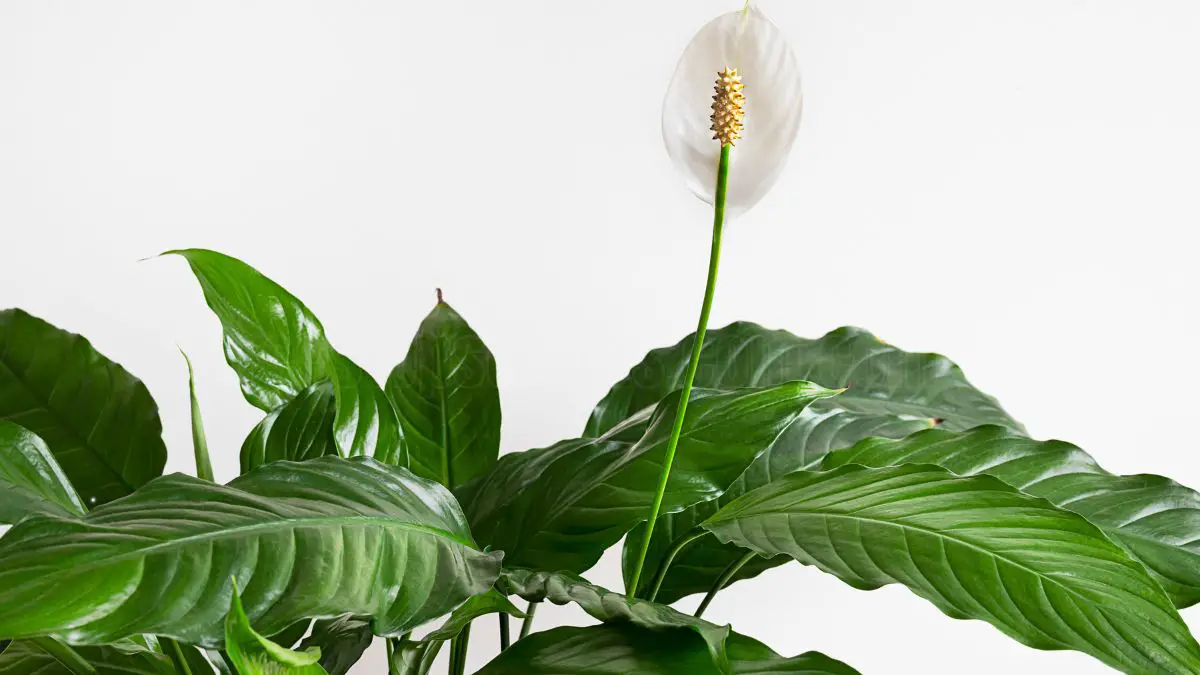Aside from their ornamental qualities, peace lilies provide multiple health benefits that improve your time spent indoors. Known for its air-purifying qualities, this plant can filter out harmful toxins like formaldehyde and benzene, making your home environment healthier.
The peace lily is helpful for much more than air quality alone. It fosters a serene environment which alleviates anxiety while enhancing your quality of life. With its stunning, shiny foliage and graceful white blooms, it makes a great addition of nature to the home or office.
This small change makes a big difference to your mental well-being. Learn how to care for your Spathiphyllum to get the most out of these benefits and enjoy an at-home calming retreat. In the remaining pages, we’ll look at detailed benefits and care instructions for this beautiful houseplant.
Key Takeaways
- In addition to their beauty, Spathiphyllum, also known as peace lilies, are outstanding natural air purifiers. They filter out toxic pollutants and purify indoor air, making them an excellent choice for homes and workspaces alike.
- These plants help regulate humidity levels, which can create a more comfortable indoor atmosphere and prevent issues like mildew formation, particularly in humid areas like kitchens and bathrooms.
- By bringing peace lilies into your home or office, you’re doing wonders for your mind. They boost relaxation, lower levels of stress and anxiety, and increase feelings of happiness and satisfaction.
- Peace lilies are not safe for pets as they are toxic to them. They have hypoallergenic properties that will help allergy sufferers in your home.
- To take care of peace lilies, make sure they get bright, indirect sunlight and develop a consistent watering schedule. Select appropriate soil to ensure vigorous growth, and be on the look out for typical houseplant pests.
- Incorporate peace lilies into your home decor to enjoy their alluring beauty and benefits. Not only do they provide relief from ailments like headaches, eye fatigue and dry throat, they freshen the air and enhance the beauty of home environments.
Health Benefits of Spathiphyllum
The Spathiphyllum, or Peace Lily, has been known to offer many health benefits. This adaptability to various environments is why it is extremely common in residential and commercial spaces. Not only does this plant thrive, but it beautifies and revitalizes your environment.
Not only does it improve indoor air quality, but it will enhance your mood and contribute to a warm, inviting living space. Knowing these advantages will help people make smart decisions about adding Peace Lilies to their environments.
1. Air Purification Capabilities
Peace Lilies, one of the most popular houseplants, are known for their incredible air cleaning power. These natural air purifiers specifically absorb harmful indoor air pollutants like benzene, formaldehyde, and carbon monoxide, significantly increasing indoor air quality. According to NASA research, Peace Lilies can effectively remove toxic substances from the air, creating a serene living environment.
- Benzene
- Formaldehyde
- Carbon monoxide
- Trichloroethylene
- Ammonia
The Peace Lily is an air purification powerhouse, capable of removing over 90 percent of benzene and formaldehyde within a day. In doing so, Peace Lilies not only eliminate dangerous indoor pollutants but also help create a cleaner, healthier environment in homes and workplaces.
They fight invisibly, providing the benefit of cleaner air without people even knowing it. Studies have found that Peace Lilies improve indoor air quality, making them ideal for enhancing both aesthetics and overall air quality in any indoor space.
2. Reduction of Harmful Toxins
These dangerous toxins found in indoor spaces can come from many common household items. Peace Lilies assist in the fight against these dangers, specifically by decreasing the presence of harmful acetone vapors and volatile organic compounds (VOCs).
VOCs are commonly found in items we use and encounter every day like oil-based paints, cleaning products, and air fresheners. By absorbing these harmful compounds, Peace Lilies contribute to a safer indoor environment.
The plant’s ability to filter out carbon monoxide and other harmful toxins is essential for maintaining healthy lungs. Decreasing the long-term exposure risks from these harmful elements improves overall well-being through cleaner air.
Keeping indoor pollution levels lower is important for all, and particularly for those with pre-existing respiratory disease.
3. Mental Health and Stress Relief
The soothing aura of Peace Lilies makes them a potent choice for improving mental health. Their broad foliage and beautiful white flowers are a great reminder of the beauty of nature which helps to create a more peaceful environment.
As a result, many individuals report that the presence of a Peace Lily in their home or workplace leads to lower stress and anxiety levels. Here are a few ways Peace Lilies can enhance tranquility:
- Promote a sense of calm
- Improve mood
- Create a peaceful atmosphere
- Encourage relaxation
With their calming influence, Peace Lilies can help create a healthier, more peaceful home environment. They clean the air around you and instill a feeling of peace. This special combination has a tremendous impact on our mental health.
4. Humidity Regulation Benefits
Peace Lilies do well in humid environments, which makes them perfect for rooms such as bathrooms and kitchens. They efficiently absorb surplus moisture from the air, protecting your plants from mildew growth.
This added humidity regulation helps to ensure general indoor comfort. Regulating humidity levels is not just about making a space feel comfortable. It has positive effects on skin and respiratory health as well.
Having the right amount of humidity in the air can help prevent dry skin and lower the chances of dry air irritating your respiratory system. By acting as a natural humidifier, Peace Lilies help prevent dry skin and irritation, proving essential in developing a more comfortable indoor environment.
5. Support for Respiratory Health
By filtering out indoor allergens and pollutants, Peace Lilies can reduce symptoms associated with respiratory distress. They filter out airborne mold spores, which can cause allergic reactions and asthma attacks.
Peace Lilies purify the air, which is particularly helpful for people with respiratory illnesses. Their cleaner air is doing even more to improve people’s overall health.
Adding Peace Lilies into bedrooms can even help improve sleep. The relaxing effect of the plant, along with its ability to purify the air, helps foster a setting that is more suitable for a good night’s sleep.
People will notice that they will start waking up feeling more rested and rejuvenated if they keep a Peace Lily next to them while they sleep.
6. Non-Allergenic Characteristics
Another attractive feature of Peace Lilies is that they are not toxic to pets. Although ingestion may lead to slight irritation, they are largely considered safe in homes with animals.
Their non-allergenic traits make them ideal for those prone to suffer from allergies, offering an ingenious touch of greenery to communal living spaces. The benefits of having non-allergenic plants such as Peace Lilies go much further than just being safe!
They produce a better indoor environment. This means they can have the beauty of nature indoors without fear of exposing themselves or their pets to allergens or sensitivities.
7. Enhancing Indoor Air Quality
Peace lilies, known for their air purifying qualities, help remove dangerous toxins and chemicals from the home, significantly improving indoor air quality and creating a serene living environment free from harmful indoor pollutants.
- Dust accumulation
- Chemical vapors
- Pet dander
- Humidity fluctuations
Care Requirements for Spathiphyllum
To help your peace lily live its best life, you need to know the basics of Spathiphyllum care. These plants are almost indestructible, requiring only occasional watering and care to flourish, so they’re great for those just starting their indoor plant journey.
Understanding their light, water, and soil requirements will ensure that they grow and thrive to their fullest potential.
1. Optimal Light Conditions
Peace lilies thrive in bright, indirect light. If they do not get enough light, they will become leggy, stop growing, and produce fewer flowers.
Ideal locations for placing peace lilies include:
- Near north or east-facing windows
- In bright, shaded corners
- Away from direct sunlight exposure
This is especially important given that winter light can be drastically different than summer.
2. Watering and Humidity Needs
Water your peace lily only when the top 2 inches of soil feel dry. This means that they need to be watered more often in summer and less in the winter.
Humidity is extremely important, so regularly misting your plant’s leaves or placing it on a humidity tray can ensure it stays hydrated, especially during dryer winter months.
Signs of watering issues include:
- Yellowing leaves (overwatering)
- Drooping leaves (underwatering)
3. Soil and Fertilization Tips
Peace lilies do best in well-draining soil. High levels of fertilizer can lead to brown leaf tips, so use fertilizer judiciously during the growing season and cut back significantly in the winter months.
Spathiphyllum thrive with balanced liquid fertilizer.
4. Common Pests and Solutions
Common pests for the peace lily plant, such as spider mites and aphids, can be managed by regularly inspecting your indoor space and ensuring it’s kept clean to prevent infestations.
5. Propagation Techniques
Propagation of the peace lily plant is best done in spring, as this popular houseplant thrives during this season, enhancing indoor spaces with its natural air purifying qualities.
- Dividing the root ball
- Replanting in fresh soil
- Keeping the new plant in a warm, humid environment
Cultural Significance of Spathiphyllum
The Spathiphyllum, known as peace lily, has rich cultural significance in many cultures. It is frequently viewed as a symbol of peace and calm. Its white flowers are associated with purity and calmness, which makes it a common symbol of peace.
In Chinese culture, the peace lily is a popular gift symbolizing prosperity and good fortune, given during celebrations. Japanese culture considers it sacred, associating it with purity and tranquility in religious rituals.
1. Symbolism of Peace and Tranquility
In eastern tradition, spathiphyllum plants are associated with peace and harmony. Their ivory flowers act as an elegant symbol of peace and tranquility. Notable references include artworks depicting peace lilies as symbols of tranquility, literature highlighting their calming presence, and folklore associating them with protection and goodwill.
Incorporating peace lilies into the home or workplace contributes greatly to one’s mental health due to its ability to promote a calming atmosphere.
2. Historical Uses in Traditions
Historically, peace lilies, known for their air purifying qualities, have been used in traditional medicine for ailments such as headaches and respiratory issues among some Indigenous cultures, representing love and compassion in many cultural rites.
3. Feng Shui and Interior Design
In Feng Shui, peace lily plants help encourage the flow of positive energy while acting as a natural air purifier. Integrating them into indoor spaces has been shown to foster a meditative calm, enhancing overall air quality and creating a serene living environment.
4. Role in Ceremonial Practices
As such, peace lily plants are popular choices for ceremonies of all kinds, from weddings to memorial services. Their air purifying qualities create a special atmosphere, a channel for expressing desires for peace and calm.
Scientific Insights on Spathiphyllum
In the past few years, scientific research has refocused interest on the peace lily, or Spathiphyllum, and its air purification properties. Learning more about how this remarkable little plant is improving our environmental health is key. This is especially critical now that city life has made us more exposed to indoor contaminants.
Scientific research has proved the therapeutic properties of peace lilies, demonstrating their effectiveness in purifying indoor air.
1. Research on Air Purification Efficacy
In fact, landmark research has shown that peace lilies are more than capable of eliminating several toxins from indoor air. To determine the effectiveness of peace lilies at removing toxins, researchers frequently use controlled environments.
Specific pollutants they can reduce include:
- Formaldehyde
- Benzene
- Carbon monoxide
- Toluene
These discoveries are especially exciting news for indoor gardeners looking to make their homes greener and cleaner.
2. Comparative Analysis with Other Plants
Compared to other common houseplants, peace lilies are exceptional air purifiers. Further, their ability to thrive in low-light conditions makes them a perfect choice for homes and offices.
Complementary plants that improve air quality include:
- Spider plant
- Snake plant
- Boston fern
Their most distinguishing feature are the peace lily flowers, elegant white blooms that contribute to their beauty in addition to their health benefits.
3. Long-term Health Benefits Studies
Long-term health benefits research studies over an extended period show that peace lilies have a beneficial effect on mental health. Regular exposure to indoor plants has shown to correlate with:
- Reduced stress levels
- Enhanced mood
- Improved focus
Growing a nature-positive world is key to ensuring continued health benefits.
Practical Tips for Incorporating Spathiphyllum
Here are some practical tips for incorporating peace lily plants into your indoor environment to maximize both aesthetic appeal and health benefits. Their elegant blooms enhance decor while serving as natural air purifiers, effectively reducing indoor air pollutants.
1. Choosing the Right Location in Your Home
Choosing the right location in your home is crucial. Choose location based on sunlight and humidity. Ideal locations include:
- Near a north or east-facing window
- Bathrooms with natural light and humidity
- Living rooms with moderate indirect sunlight
Keep away from drafts and extreme temperatures, as this will impede growth. The right location makes all the difference in your peace lily staying happy and healthy.
2. Pairing with Other Indoor Plants
Pairing peace lilies with other types of indoor plants can help you create a dense, tropical-looking environment. Some compatible options are:
- Snake plants
- Pothos
- Ferns
These plants have similar requirements for light and humidity, making them very compatible.
A mixed arrangement creates depth and visual intrigue that will amplify your tropical indoor garden aesthetic.
3. Using as a Natural Décor Element
Using peace lilies as a natural décor element can enhance your space. They are beautiful accent pieces. Creative display ideas include:
- Centerpieces on dining tables
- Accent pieces on shelves
- Corner stands in living rooms
Their soothing presence adds to a relaxing environment. This dual role as both a decorative and functional plant makes peace lilies incredibly valuable additions to any home.
Conclusion
Spathiphyllum, or peace lily, delivers tons of health benefits right to your doorstep. It purifies the air around you, increases your happiness, and brings a sense of peace and beauty. With a little bit of care, you can ensure its continuous, lively presence. This stunning and graceful plant has deep cultural roots. People have loved it for centuries, adding another layer of beauty and meaning. Science supports its benefits, which makes it a smart addition to any space.
If you don’t have a spathiphyllum already, think about adding one to your home. It’s a beautiful plant that will not only make your surroundings more uplifting, but it will help you feel better. Take advantage of all the beauty and health benefits this remarkable plant has to offer. Welcome the peace lily into your home and experience the difference it can make.
Frequently Asked Questions
What are the health benefits of Spathiphyllum?
The peace lily plant, a popular houseplant, acts as a natural air purifier, effectively removing indoor pollutants like formaldehyde and benzene while enhancing humidity for a healthier living environment.
Is Spathiphyllum safe for pets?
To answer your question, is the peace lily plant safe for pets? Yes, but it should be kept out of reach from pets. As with any indoor plant, maintaining a safe environment for curious creatures is essential.
How often should I water my Spathiphyllum?
Only water your peace lily plant when the top 1 inch of soil is dry to the touch. For most indoor plant growers, that translates to watering once a week or every other week, depending on the humidity levels in your living environment.
What light conditions are best for Spathiphyllum?
For optimal care of the peace lily plant, avoid harsh, direct sunlight that can burn its glossy leaves, and instead provide indirect light to ensure a thriving indoor space.
How do I repot my Spathiphyllum?
When repotting your peace lily plant, which is known for its air-purifying qualities, select a new container that is no more than an inch or two bigger than the existing one. Carefully lift out the plant, refresh the soil, and set it back into the new container. After repotting, give your plant a good watering to support its growth in your indoor space.
Can Spathiphyllum bloom indoors?
Yes, if you provide proper indoor care for the peace lily plant, you will be rewarded with beautiful white blooms. Ensure it receives fine light and humidity for optimal growth in your indoor space.
How do I care for my Spathiphyllum during winter?
During winter, water less often because the peace lily plant’s growth rate will be reduced. It's ideal to keep this natural air purifier in a warmer location, away from drafts, while maintaining high humidity to help it flourish.
Image Source: Paid image from CANVA





